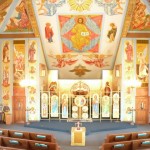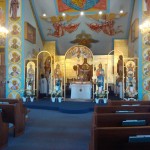The Open Doors to Heaven
Apr 26th, 2011 | By J. Andrew Deane | Category: Blog PostsMy eldest son is an altar boy. His job sometimes seems mostly symbolic, but there are times when I can tell that his work for the Church is important. In an Eastern parish, we have a clear delineation separating the altar from the rest of the church building. This stock photo from my church website shows that quite clearly. There are 3 main doors, the two on the sides (sometimes called the deacon’s doors), and the central doors, known also as the holy doors. On almost every occasion, only ordained men are allowed to enter them. This symbolizes the great holiness of the heavenly realm.
Between Good Friday and Pascha (Easter), there is a beautiful commemoration of the death of Christ with a woven image of Christ’s burial that rests on a “tomb” that reminds the faithful of what our Gracious Lord endured for our sake.
When I first saw my son serving as an altar boy on Holy Saturday, I was shocked by a simple procession that my priest and spiritual father made on that fateful day. He placed the shroud over his head and held it in his hands as he walked through those holy doors. As he got close to the holy doors, I noticed that his hands were full, because he was holding the burial shroud. I saw my young son and hoped he would grab the door to open it for our priest. To my dismay, he wasn’t moving towards the doors. Instead, I was shocked to see our priest come up to the door and knock the doors open with a swift jerk of his head. He had headbutted the holy doors open!
Was this a mistake because of my sluggish son? I learned this was definitely not the case. Instead, the celebration of the Resurrection of Christ led to an opening of the Holy Doors. As violent as it seemed, my priest was not opening the doors with his head because of anger, but because of the conquering victory of Christ, who is risen from the dead. From Pascha (Easter) Sunday through Bright Saturday, the doors that symbolize the division between the heavenly kingdom and earth are left open, because Christ opened the division through his death and resurrection.
The idea that Tradition leads to a division between the people of God and our Lord is therefore a gross oversimplification of what we believe and practice.
It emphasizes that despite our regard for holiness and the like, we acknowledge that the saving work of Christ has led to a breaking down of those barrier walls. Everything that keeps us from holiness and divinization has been accomplished through the cross.
May this year’s bright week lead to a breaking down of the barriers that keep us from His Love, in the name of the Father, and of the Son, and of the Holy Spirit.




Hey, look at all those pews!
The Orthodox would bump our heads on the pew in front of us at the Trisagion prayer :-)
Holy headbutt—so cool. The image of Christ’s resurrection should be something we not only revel in as a distant and sweet memory, it should be something that astonishes us. Great account of that realized in the Eastern Catholic liturgical tradition. Thanks JD :)
Christ is Risen! Alleluia!
Pax,
Steve
Christ is Risen!
Canadian,
You bring up a somewhat funny point that is not only an issue for some Byzantine Catholics, but also for some (American, at least) Greek Orthodox. A desire to be more American/Western has led to some Eastern parishes to adopt practices like having Pews. To my knowledge, no Byzantine Catholic parish has other Western elements like an organ, though I have seen one in the choir loft of a Greek Orthodox parish. Believe me, despite the pews, I can make a deep metania at the Trisagion and during the anaphora. Be that as it may, it is somewhat stifling. Nevertheless, I was writing to think more about the nature of the holy doors and the deacon’s doors. Bright Week sends us a special message that is really a clear pronouncement that Christ has opened the kingdom of heaven to all. Blessed is the Kingdom of the Father, and of the Son, and of the Holy Spirit!
Truly He is Risen!
Andrew,
Yes, from what I understand seating in church for the faithful was made widespread only after the Reformation.
Do you have the filioque in your creed, commune children, or receive both body and blood by spoon in eastern Catholicism?
Canadian,
As Eastern Catholics, we do not use the filioque in the Creed,
my infant daughter and other kids under the “age of reason” are baptized, chrismated, and receive communion regularly,
and we receive the body and blood of Christ under the forms of leavened bread and wine by spoon.
Blessings,
J. Andrew